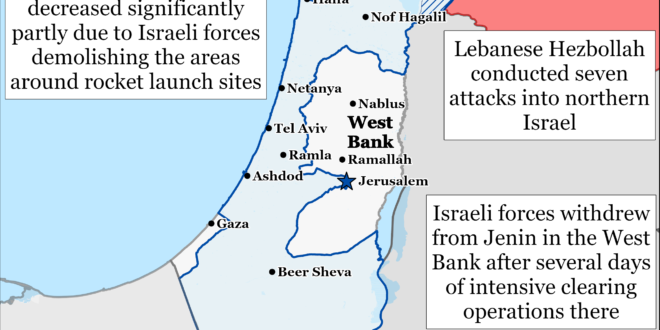Iran has sent hundreds of short-range ballistic missiles to Russia to support Vladimir Putin’s invasion of Ukraine, according to the Wall Street Journal.[1] An anonymous European official told the outlet that more shipments of Iranian missiles to Russia are expected.[2] Iran and Russia previously signed a contract in December 2023 to send Iranian Ababil close-range ballistic missiles and Fateh-360 short-range ballistic missiles to Russia.[3] Ababil missiles have a range of around 86 kilometers and can carry a payload of 45 kilograms, while Fateh-360 missiles have a range of around 120 kilometers and can carry a payload of 150 kilograms.[4] It is unclear, however, exactly what kind of missiles are included in the recently delivered shipment to Russia. Iran has meanwhile expanded at least two of its defense industrial sites outside Tehran throughout 2024 to support the production of drones and missiles, some of which are meant to go to Russia, according to Reuters.[5] Russia has recently intensified drone and missile attacks into Ukraine, notably continuing to use Iranian-developed Shahed-131/136 drones and North Korean ballistic missiles.[6] Russia will likely use Iranian-provided ballistic missiles to target Ukrainian energy, military, and civilian infrastructure over the coming Fall-Winter season to further destabilize Ukrainian society and to disrupt Ukraine’s defense industrial base.
The missile shipment is part of the deepening strategic partnership between Iran and Russia. CTP-ISW has reported extensively on how Moscow and Tehran have expanded their economic, media, military, and political cooperation since Russian forces invaded Ukraine in February 2022.[7] That cooperation has included, among other things, the heavily scrutinized sale of Iranian drones to Russia to use against Ukrainian civilian and military targets.
Iran seeks to benefit economically and militarily from its expanding partnership with Russia. Iran has sought cash for its ailing economy in return for selling weapons to the Kremlin, as CTP-ISW reported in September 2023.[8] Iran has also sought to procure Russian Su-35 fighter jets.[9] Iranian officials “pressed” for the delivery of Su-35s during a meeting with Russian Security Council Secretary Sergei Shoigu in Tehran in August 2024.[10] The acquisition of Su-35s could enable Iran to more readily and independently project air power, given that the current Iranian air fleet is outdated and poorly maintained.[11] Iranian leaders have separately sought Russian support in upgrading their cyber capabilities and missile and space programs as part of the expanding military collaboration.[12]
US and European officials have threatened in recent months to impose sanctions on Iran in response to the sale of missiles to Russia.[13] The United States and unspecified European countries have reportedly prepared a sanctions package against Iran for this contingency.[14] These sanctions could include banning Iran Air from flying to European airports.[15]
The rate of Palestinian militia rocket attacks from the Gaza Strip into Israel has decreased significantly in recent weeks. Israeli media reported that this decrease is due to the Israel Defense Forces (IDF) beginning to immediately evacuate Gazan residents in areas from which rockets are fired and then demolishing buildings in the area.[16] This approach often includes Israeli airstrikes targeting rocket launch sites.[17] The IDF has reportedly pursued this approach regardless of the volume of rockets fired or where the rockets landed.[18] CTP-ISW has observed rocket launches from the Gaza Strip into Israeli territory decrease significantly since June 2024, which is consistent with the reporting of this new Israeli approach. The decrease is also likely due to the Hamas stockpile of rockets dwindling.[19] Gazan residents have reportedly pressured Hamas to refrain from firing rockets from certain neighborhoods in response to this new Israeli approach.[20] Clashes have erupted between Hamas members and local residents in some cases, according to Israeli military officials. An IDF source said that, in one incident, a Gazan clan attacked Palestinian fighters with clubs as the fighters tried to fire a rocket.[21]
Hamas has begun exploring new ways to pressure the Israeli public as firing rockets has become harder. Hamas has relied on its rockets for years to impose such pressure. But the loss of its stockpile and new Israeli approach have made this option decreasingly viable. Hamas has thus begun calling for suicide bombing attacks targeting civilians in Israel.[22] Hamas claimed responsibility for an attempted suicide bombing in Tel Aviv in August 2024, marking the first time that Hamas has made such a claim since 2008.[23]
Hamas continued to conduct an information operation to decrease Israeli willingness to continue fighting in the Gaza Strip and to pressure Israel to end the war on terms favorable to Hamas. Hamas released two propaganda videos on September 5 and 6 depicting two recently killed hostages calling for a ceasefire.[24] These videos are meant to drive the Israeli public to pressure the Israeli government to accept an immediate ceasefire-hostage deal with Hamas. Hamas has separately issued new demands in recent days by increasing the number of Palestinian prisoners whom Israel must release in a ceasefire-hostage deal, according to anonymous US officials.[25] The return of these Palestinian prisoners would support Hamas’ efforts to rebuild its military wing. The issuance of new demands has made the United States doubt whether Hamas sincerely wants a ceasefire-hostage deal.[26]
Israeli officials are reportedly pessimistic about the prospects of a ceasefire-hostage deal. Israeli Prime Minister Benjamin Netanyahu met with his national security team on September 5 to discuss how to respond to Hamas recently executing six hostages.[27] Israeli Army Radio reported that Israeli officials left the meeting feeling ”pessimistic” and added that ”the chances of a deal are slim.”[28]
Iranian officials have continued expressing their opposition to Azerbaijan’s efforts to connect its mainland to its Nakhchivan exclave by going through Armenia.[29] These comments are in response to Russia changing policy to support this connection, which is known as the Zangezur Corridor.[30] Former Islamic Revolutionary Guards Corps (IRGC) Commander Mohsen Rezaei said that Russian support for the Zangezur Corridor is unacceptable and contradicts the Iran-Russia strategic partnership.”[31] Iranian Ambassador to Armenia Mehdi Sobhani similarly told reporters on September 6 that “dreams about the Zangezur [Corridor] will not come true.”[32] IRGC-affiliated media separately published an article stating that Russia has “adopted a wrong position regarding that Zangezur Corridor that is incompatible with Iran’s interests and red lines.”[33] Tehran has long opposed the development of the corridor because it would sever Iranian land access to Europe and Russia via Armenia.[34]
Senior advisers to Iranian Supreme Leader Ali Khamenei met with members of the newly formed Masoud Pezeshkian administration on September 4. Yahya Rahim Safavi, who is a senior military adviser to Khamenei, met Pezeshkian’s foreign minister, health minister, interior minister, and science minister.[35] Safavi stressed the importance of ”constructive interaction” between the Iranian armed forces and Pezeshkian administration. Ali Akbar Velayati, who is a senior foreign policy adviser to Khamenei, separately met with some senior policy officials in the Pezeshkian administration.[36] Iranian opposition outlets have described these meetings as ”unprecedented,” which is consistent with CTP-ISW’s tracking. The meetings between Khamenei’s advisers and the Pezeshkian administration reflect the close coordination between them.[37] Pezeshkian has repeatedly emphasized his subordination to Khamenei and appears to be coordinating his agenda and policies with Khamenei’s inner circle directly.
Key Takeaways:
- Iran-Russia: Iran has sent hundreds of short-range ballistic missiles to Russia to support the Russian invasion of Ukraine. Russia will likely use the missiles to attack Ukrainian civilian and military infrastructure over the coming months.
- Gaza Strip: The rate of Palestinian rocket attacks from the Gaza Strip into Israel has decreased significantly in recent weeks partly due to the IDF beginning to immediately evacuate areas from which rockets are fired and then demolishing buildings in the area.
- Israel-Hamas ceasefire-hostage negotiations: Hamas has continued to conduct an information operation to erode Israeli willingness to continue fighting in the Gaza Strip and to pressure Israel to accept a ceasefire-hostage deal on terms favorable to Hamas.
- Caucasus: Iranian officials have continued expressing opposition to Azerbaijani efforts to link Azerbaijan proper to its Nakhchivan exclave going through Armenia. Tehran is responding to Russia changing its policy to support this connection.
- Iran: Senior advisers to Iranian Supreme Leader Ali Khamenei met with members of the newly formed Masoud Pezeshkian administration. These meetings reflect the close coordination between Khamenei’s and Pezeshkian’s circles.
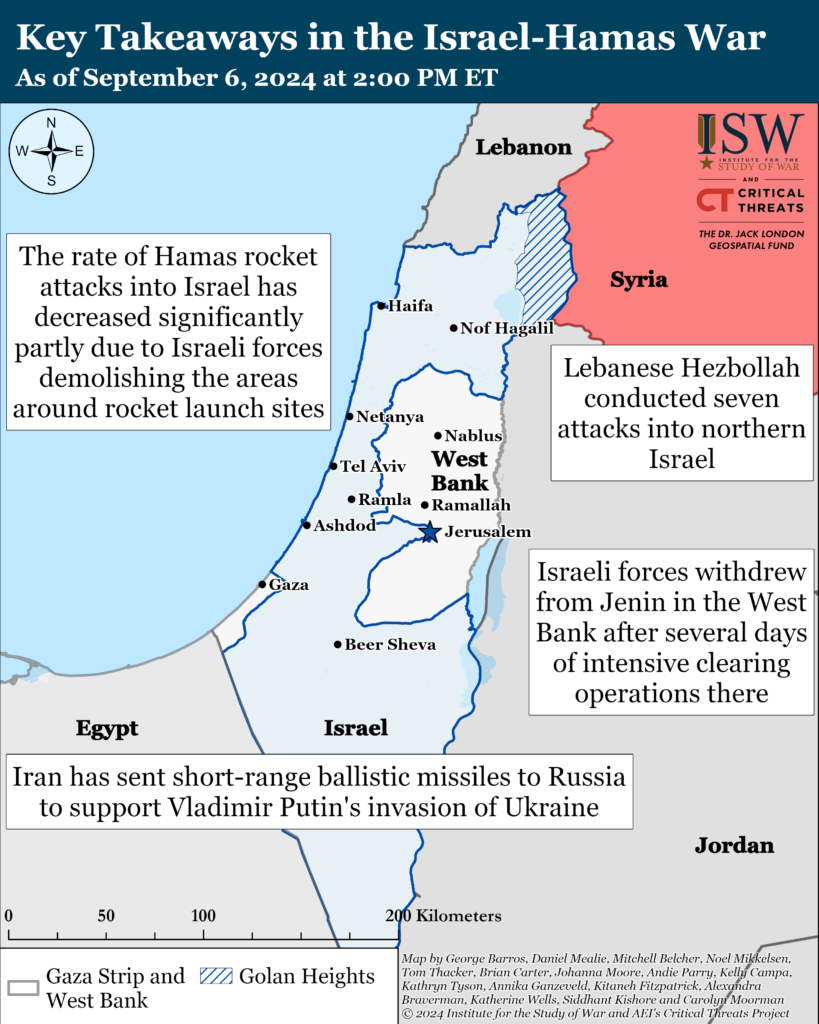
Gaza Strip
Axis of Resistance objectives:
Erode the will of the Israeli political establishment and public to sustain clearing operations in the Gaza Strip
Reestablish Hamas as the governing authority in the Gaza Strip
Israel and Palestinian militias continued to observe limited humanitarian pauses in select areas of the southern Gaza Strip to enable the vaccination of Palestinian children for polio on September 6.[38] UNRWA confirmed on September 5 that aid groups had moved vaccination operations to the southern Gaza Strip.[39] UNRWA said that it vaccinated over 152,000 children in Khan Younis city, 8,880 in Rafah, and 1,000 in other areas on September 5.[40] International aid groups intend to vaccinate 340,000 children in the southern Gaza Strip by September 7 before starting the third and final phase of the vaccination campaign on September 9 in the northern Gaza Strip.[41] The Israeli Prime Minister’s Office has emphasized that the pause in fighting is not related to the longer-term ceasefire-hostage proposal currently under discussion.[42]
The IDF has continued limited military operations outside the vaccination ceasefire zones in the Gaza Strip over the past week.[43] Israeli forces have attacked and destroyed over 40 militia infrastructure targets across the Gaza Strip, including command-and-control sites located in schools, colleges, and humanitarian areas.[44] The IDF has also killed over 100 Palestinian fighters and located several underground tunnel shafts.[45]
Palestinian sources reported that Israeli forces operated around the Netzarim Corridor on September 6. A Palestinian journalist reported small arms fire and shelling south of Gaza City.[46] Palestinian residents told Reuters that Israeli tanks have been operating in Zaytoun in southern Gaza City for over a week.[47] A Palestinian journalist also reported IDF small arms fire north and northwest of Nuseirat refugee camp.[48] Commercially available satellite imagery captured on September 6 showed flattened terrain along Wadi Gaza, north of Nuseirat, indicating that Israeli tanks or bulldozers operated in the area. The IDF has operated around the Netzarim Corridor in recent weeks in order to expand IDF control over territory along the corridor.[49]
Two Palestinian militias conducted mortar attacks targeting Israeli forces east of Rafah city on September 6.[50]
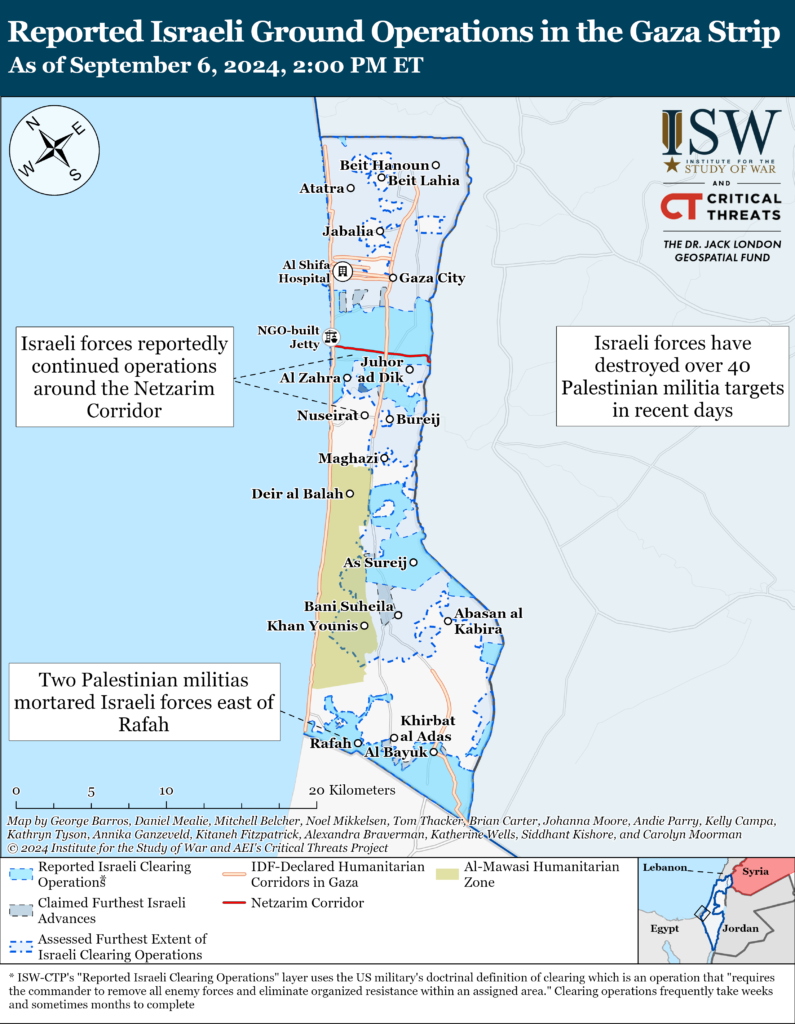
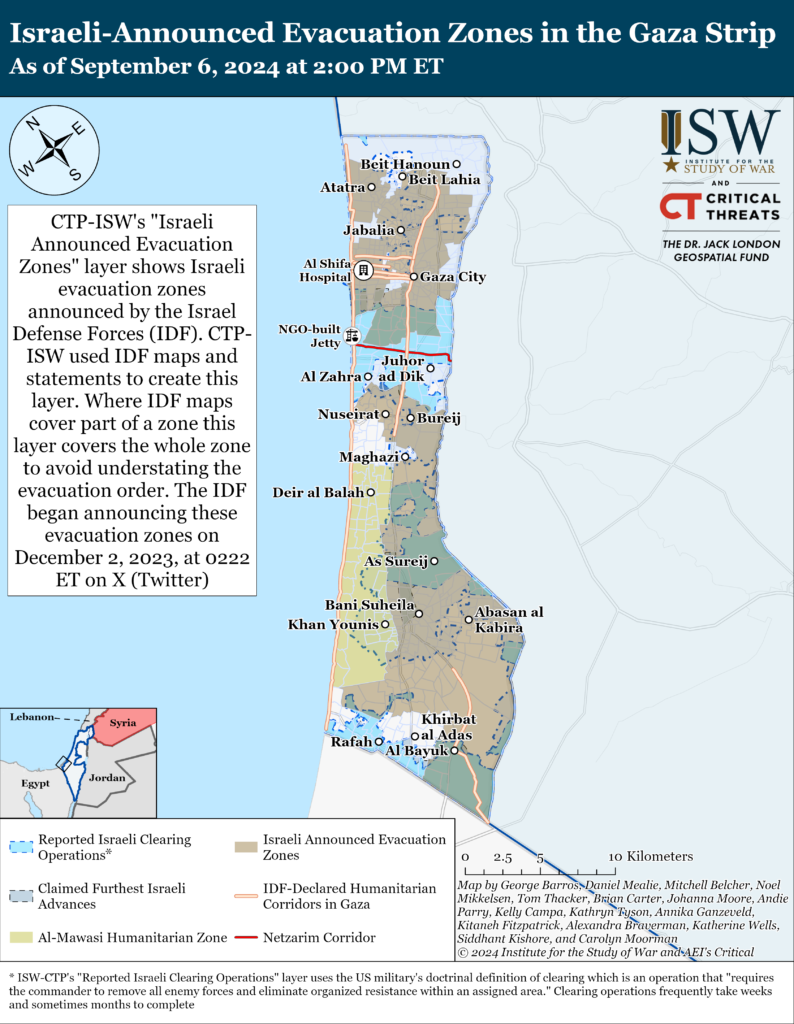
West Bank
Axis of Resistance objectives:
Establish the West Bank as a viable front against Israel
Israeli forces withdrew from Jenin on September 6 but will reportedly return “soon” to continue the large-scale counterterrorism operation that the IDF has conducted to degrade Palestinian militia networks across the West Bank in recent days.[51] The IDF has operated for ten consecutive days in Jenin since the launch of Operation Summer Camp on August 27.[52] The IDF launched the operation in response to Hamas’ attempted suicide bombing in Tel Aviv in August 2024.[53] Anonymous security officials told Israeli Army Radio correspondents that Israeli forces will return to Jenin ”soon” and that Operation Summer Camps is not over.[54] The IDF separately stated that Israeli forces will continue with the operation until IDF objectives are achieved.[55] The IDF, Shin Bet, and Border Police have killed 14 fighters, detained 30 suspects, destroyed 30 IEDs planted under roads, and conducted four airstrikes over the past 10 days in Jenin.[56] The IDF also announced on September 6 that it had killed Hamas’ Jenin commander, Wassem Hazem.[57] Hazem directed small arms and IED attacks in Jenin and promoted militia activity across the West Bank. Hamas has not confirmed Hazem’s death at the time of this writing.
Israeli forces have engaged Palestinian fighters in at least seven locations in the West Bank since CTP-ISW’s last data cutoff on September 5.[58] PIJ detonated two IEDs targeting an Israeli military vehicle south of Jenin.[59] PIJ claimed that the IED attack caused Israeli casualties.
The IDF is currently investigating the death of Turkey-born US citizen Aysenur Eygi who was killed near Nablus on September 6 during a protest against Israeli settlements in the West Bank.[60] Palestinian media reported that the IDF shot Eygi.[61] An initial Israeli investigation into the incident revealed that Israeli soldiers fired small arms targeting “a main instigator” who “posed a threat” and that one protester was hit.[62] The IDF is currently investigating claims that a foreign citizen was killed by gunfire.[63]
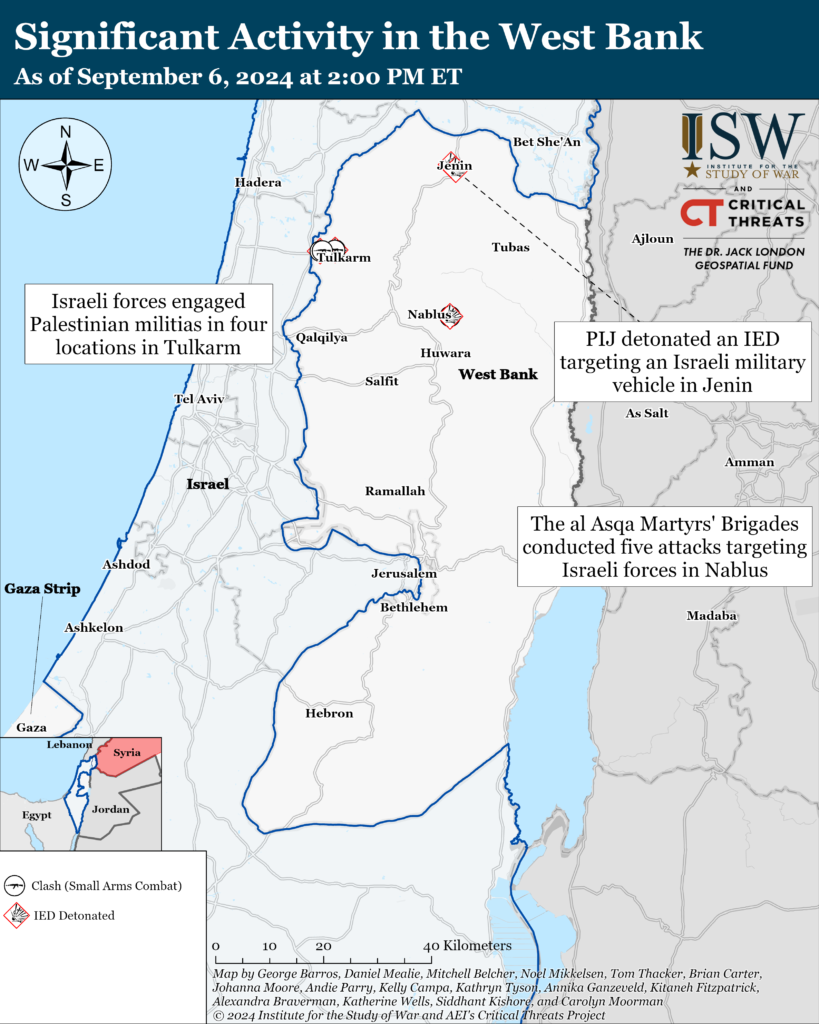
Southern Lebanon and Golan Heights
Axis of Resistance objectives:
Deter Israel from conducting a ground operation into Lebanon
Prepare for an expanded and protracted conflict with Israel in the near term
Expel the United States from Syria
Lebanese Hezbollah has conducted at least seven attacks into northern Israel since CTP-ISW’s last data cutoff on September 5.[64]
IDF Chief of Staff Lieutenant General Herzi Halevi discussed military preparations for a potential conflict on the Israel-Lebanon border with several IDF commanders in the Golan Heights on September 6.[65] Halevi met with IDF Northern Command Commander Major General Uri Gordin and 210th Division Commander Brigadier General Yair Peli, and other unspecified commanders.[66] Halevi said that the IDF is “very focused“ on fighting Hezbollah and is preparing “offensive actions“ against Hezbollah in Lebanon.[67] Halevi said that the IDF is attacking Hezbollah capabilities before Hezbollah can attack Israel.
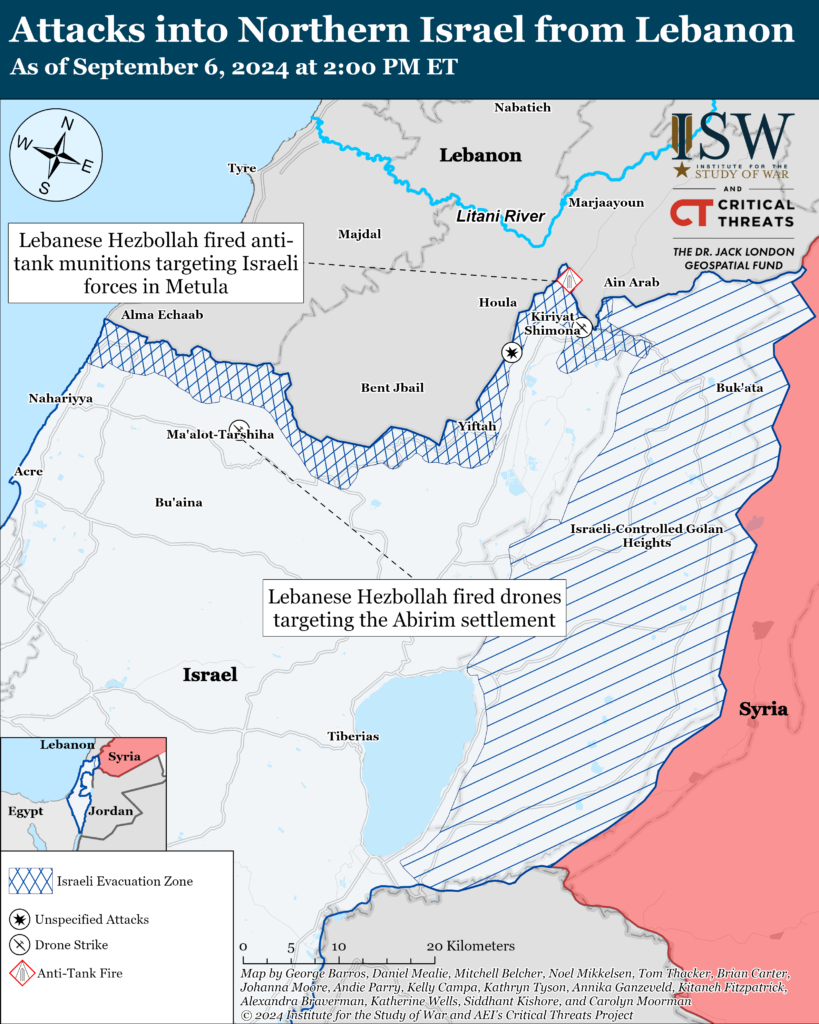
Iran and Axis of Resistance
The United States and Iraq have agreed to withdraw US forces from Iraq by 2026 with the possibility that some US advisers remain in country, according to Reuters.[68] US, coalition, and Iraqi sources told Reuters that “hundreds” of coalition forces will withdraw from Iraq by September 2025 and remaining troops will withdraw by the end of 2026. The United States currently has approximately 2,500 advisers in Iraq under Combined Joint Task Force-Operation Inherent Resolve supporting efforts to enable Iraqi forces to bring a lasting defeat of ISIS.[69] A senior unspecified US official cited by Reuters reported that “we have an agreement, it’s now just a question of when to announce it.”[70]
The United Kingdom Maritime Trade Operations (UKMTO) reported a small vessel tried to approach a merchant ship 60 nautical miles southwest of al Hudaydah, Yemen, on September 6.[71] A small craft with three individuals onboard approached within 400 meters of the merchant ship. The security team on the merchant ship displayed their weapons, and the small craft then retreated.
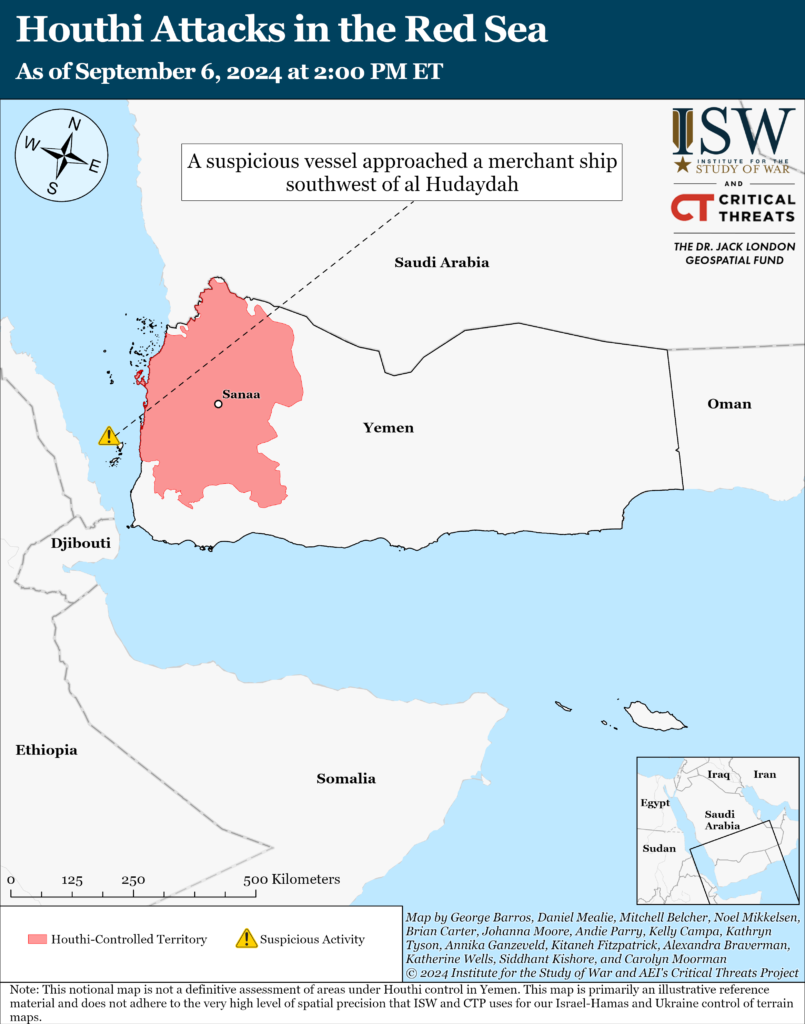
Iranian Foreign Affairs Minister Abbas Araghchi and Bahraini Foreign Affairs Minister Abdullatif bin Rashid al Zayani discussed normalizing relations between Iran and Bahrain during a phone call on September 5.[72] Araghchi stressed the importance of Iran’s neighborhood policy and the development of bilateral relations between Iran and Bahrain. Zayani expressed his hope that joint dialogues between Iran and Bahrain will advance ”in the new period.” CTP-ISW previously reported that Iran has been seeking to restore diplomatic ties with Bahrain since May 2024.[73]
Araghchi also held a phone call with Serbian foreign minister Marko Jurich on September 6 to discuss “economic and commercial” cooperation.[74] Araghchi and Jurich expressed their respective countries’ interests in expanding bilateral economic cooperation. Jurich also invited Iran to participate in the 2027 Belgrade Expo. Jurich thanked Iran for its support of Serbian territorial integrity. Araghchi thanked Jurich and stated that one of Iran’s primary foreign policy objectives is to strengthen stability in the Balkans.
Russian President Vladimir Putin stated on September 5 that Iran has been asking Russia for gas “for a long time.”[75] Iran often faces gas shortages, despite having the second largest natural gas reserves in the world, partly due to high domestic demand.[76] Iran and Russia signed a memorandum of understanding in June 2024 in which Russia would export 300 million cubic meters of gas per day.[77]
 Eurasia Press & News
Eurasia Press & News
